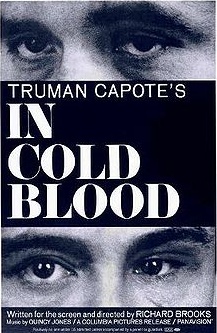Washburn UniversityCenter for Kansas Studies


In Cold Blood
Article Written by: Philip Heldrich, Emporia State University
*Article used with permission from the Kansas Historical Society*
Perhaps one of the most difficult types of filmmaking must be the film adaptation based on an already successful and well-known text. Such an adaptation, because of a book’s recognition, opens itself up to countless comparisons and criticisms. However, the art of film adaptation lies less in fidelity to the original text and more in the creation of a unique perspective on that text. In few movies is the success of this particular art more evident than in Richard Brooks’s adaptation of Truman Capote’s In Cold Blood (1965). Although the film captures much of the intention of Capote’s original bestseller, it also takes a number of significant departures that have made Brooks’s In Cold Blood a milestone of popular culture and Kansas history, solidifying Kansas’s place as a significant cinematic symbol and remembered landscape.
Some thirty-four years since the film’s release in December 1967, In Cold Blood remains fresh, unsettling, and audacious. The terror Brooks captures through both his extended focus on criminal psychology and the murder scene in the actual Clutter home is still amply troubling; few films today can capture the horrendous nature of violence without actually portraying most of it on screen. In Cold Blood remains significant as well because it speaks strongly about living in a chaotic, fractured, postmodern world where we can, like the Clutters, become victims of circumstance and chance at any moment and in any place, even in Kansas. Amore enduring quality of the film, however, is its social criticism with respect to class disparity and racial difference. In the social upheaval of the late sixties, Brooks challenges us, surely more than Arthur Penn’s romanticized Bonnie and Clyde (1967), to think about how real economic and racial inequality can create criminal behavior capable of destroying peaceable, middle-class lives like those of the Clutters.
Brooks’s insistence on filming in black-and-white, often on location in Kansas, and Quincy Jones’s original music stand out as In Cold Blood’s most striking and enduring aesthetic attributes. The film—which used the Clutter home, the actual courtroom, seven of the twelve original jurors, the same hangman, and Nancy Clutter’s horse—seems infused with a blending of fact and fiction, just as did Capote’s “nonfiction novel.” Jones’s music is likewise powerful, strongly emphasizing the film’s linear fragmentation and its characters’ discordant lives. Jones provides a memorable, menacing jazz with horn shrieks, bass moans, and arrhythmic percussion. Such jazz plays an especially important role in the initial scenes, establishing the criminal, socially marginal personalities of Perry Smith and Dick Hickock. Smith, played exceptionally by Robert Blake, comes across as a detached, unbalanced, homosexual drifter, an unsteady and anxious half-Indian outsider. Hickock, played by Scott Wilson, is a degenerate, sexually charged hipster from a poor Kansas family, not unlike Dorothy’s family in The Wizard of Oz. Jones’s music has such a strong presence throughout the film that silence itself becomes significant, particularly in the Clutter murder scene and in the film’s final moments during Smith’s hanging; respectively, blowing wind and a heartbeat punctuate the solemnity of both moments as violations of human life, even of killers’ lives forged, as the film suggests, in conditions of social and racial inequality.
The film’s setting, too, is important for creating of Kansas a symbolic landscape relevant to the turmoil of the late sixties. In this stark place, society’s insolvent and colored outsiders clash with the heartland’s upstanding, hard-working citizens: “Welcome back to Kansas, buddy, the heart of America,” Dick tells Perry at the film’s onset, “the land of wheat, corn, Bibles, and [belch] natural gas.” Brooks plays off Kansas history in the popular imagination, the land of John Brown and Carrie Nation, a land of racial conflict and religious fervor. Kansas also is a land of haves and have-nots, as Dick makes clear: “Doctors and lawyers, what do they care? Ever see a millionaire fry in the electric chair? Hell no. There’s two kind of laws, honey, one for the rich and one for the poor.” Even in Kansas, the film suggests, there is social disparity and its accompanying problems. A violation of Kansas becomes akin to a violation of home—Dorothy’s, our nation’s, and, literally, the Clutters’—a theme consistent with Capote’s book. It is also not surprising that the criminals hide out in the wild lands of Mexico and are apprehended in Las Vegas, as such illicit places, conceptually outside the law, contrast heavily with the myth of Kansas as homeland—there’s no place like it—in our cinematic and literary history.
Another departure the film takes from the text, the addition of the reporter, perhaps sheds the most light on the nature of both Capote’s and Brooks’s works and the lasting significance of each for Kansas and American history. When asked of his interest in the crime, the reporter responds: “A violent, unknown force destroys a decent, ordinary family. No clues. No logic. Makes us all feel frightened, vulnerable.” Brooks’s own words during filming to William Cotter Murray of the New York Times further defines the film as “Greek tragedy, American style . . . . If I thought this movie didn’t have relevance to a general social problem, I wouldn’t be making it.”8 In these murders, as both Brooks and Capote define them, we are all held partly responsible. In choosing not to confront the killers and their crime, we turn our backs on the social problems of racial difference and class disparity that gave rise to Smith and Hickock. For the late 1960s, and perhaps still now, Brooks serves up a biting social critique of postmodern American life. By the end of the film, as with Capote’s bestseller, trouble in Kansas means trouble everywhere. Surely, if the heart ails, there can be no health in our nation’s body.
Philip Heldrich
Emporia State University
8. William Cotter Murray, New York Times, April 16, 1967, II, 15.
